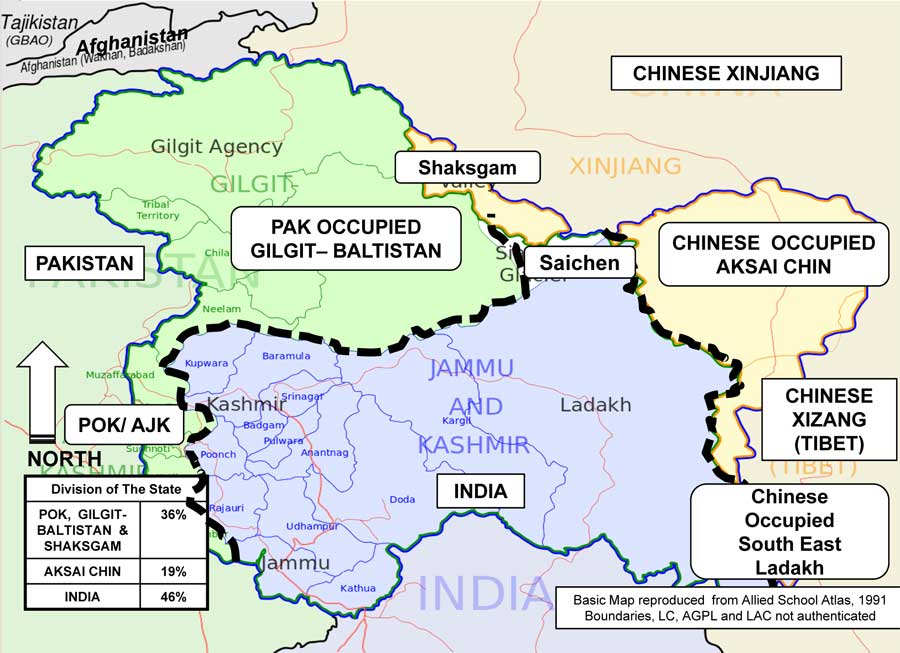We shall be entering twenty-eighth year of sponsored Kashmir insurgency. The bloodshed on either side has neither thrown out India nor brought in Pakistan.
The position of Kashmir uprising is far weaker today than what it was in 1990s or early 20s. The world community is convinced that Kashmir is part of Islamic Theo-fascism.
Pakistan sponsored Theo-fascism has done tremendous harm to the cause of Kashmir secessionists. World community clubs them with Islamic revivalist, the annexure of Wahhabi/Salafi chapters.
The US and the European Union recognize Pakistan the epicentre of world terrorism. Even China and Russia also endorse this view. It has given leverage to India like to screw up anti-terror operations.
The nature of Sino-Pak camaraderie – Gwadar, CPEC and proposed gas and railway line across KKH and leasing out GB to PLA is become catalyst to power polarization in which the sub-continent and India-Pacific emerge as probable conflict zones
Hafiz Saeed’s release from home arrest and his thuggish initiating of All Pakistan Kashmir campaign might have boosted the morale of Kashmir secessionists and jihadists, yet the statement of Pak PM Abbasi before Asia Centre in New York that Pakistan does not recognize independence of Kashmir as realistic has taken the wind out of the sails of Hafiz’s tantrum. Abbasi’s statement has de-legitimized the twenty-eight year old “aazaadi” slogan of Kashmir secessionists.
More than two hundred jihadi militants have been eliminated by security forces within a short period of two months. The Kashmir police and security forces have deepened and widened their intelligence network with very encouraging outcome. This is a sequel to militants targeting policemen and their homes in South Kashmir.
One more significant result is increasing surrenders among militants. Hartal calls have come down and response to the calls has also been on downslide. The reason is that Kashmiri youth have begun to understand the futility of a movement manned by remote control.
A major blow to separatist leadership with damaging repercussions for the unsuspecting masses of Kashmiri people has come from the arrest of about a dozen of their second rung leaders including accomplices by NIA on charges of huge hawala transactions. What the NIA has so far revealed of the case is only the tip of the iceberg.
Trump administration has mounted pressure on Pakistan to wind up safe havens for Haqqani and Taliban fighters on its soil in Quetta and other places. Islamabad has been deputing civil and military envoys to Washington to mollify the White House and remind it how Pakistan has contributed to the dismemberment of Soviet State. Trump is already in cahoots with Putin and Pakistan stands sidelined in the combination and permutation of strategic calculus of the region.
Chahbahar venture is only the first step in a comprehensive counter strategy of India-Pacific actors in neutralising the impact of CPEC. Of late, Beijing is having second thoughts on its OBOR formula.
China’s recently established military base in Skardu and massive presence in Gilgit region is a big challenge to the entire region. The widening of KKH, plan for rail and gas line and above all making of 22 secret tunnels through which the KKH passes are no small strategic moves.
After heavy Chinese presence in Gilgit, Pakistan is reported to have allowed China establish Chinese military base in Skardu (Baltistan), about 23 kilometers from Kargil. Islambad is reported to be examining China’s proposal of establishing a military base in North Waziristan. China also plans link with Afghanistan via Wakhan Corridor enabling shipment of precious Afghan copper ore to China besides military equipment.
Evidently, Gilgit-Baltistan is becoming an important geo-strategic region on the proposed CPEC. China is supporting Pakistan’s Kashmir stand, overtly and covertly. This makes Indian part of J&K State vulnerable to combined Pakistani and Chinese aggressive designs. This will pose unimaginable threat not only to the security of Indian sub-continent but the entire Asian region as well.
Situated between the Himalayan ranges, Gilgit-Baltistan lies at the confluence of Central Asia, China and South Asia. It borders Wakhan Corridor of Afghanistan; Xinjiang Province of China, Pakistan’s Khyber-Pukhtunkhwa Province, Pakistan occupied Kashmir and Indian State of Jammu and Kashmir.
Its geography offers the advantage of being the vital hub for trans-region exchanges. Pakistan and China have together exploited this region’s importance to push their geo-strategic and economic objectives. China feigns neutrality on Kashmir but issues visa to Indian Kashmiris on a separate sheet. PLA intermittently violates the LOAC in Ladakh region arguing that Sino-Indian border is not formally delineated. China thrice vetoed US-UK proposal in the Security Council seeking to designate a Pakistani terrorist sending armed gangsters into Indian Kashmir.
How China is pursuing its double game will be seen from the fact that in recent trilateral conference of foreign ministers in New Delhi, her foreign minister endorsed the joint statement of fighting terrorism on international plane?
Nearer home, Kashmir leadership conditioned by narrow local issues and blinded by lust for political power cannot come out of its cocoon to envision the unfolding scenario in its close proximity in the north.
The nostalgia of dynastic rule makes Dr. Farooq walk behind the Hurriyatis. It is like a myopic pedestrian holding the hand of a blind man. The PDP leadership betrays no less signs of myopia when insisting on opening the strategic Kargil-Skardu link
Kashmir leadership of all hues needs cool and considerate re-evaluation of the ground situation across the sub-continent and opt for revision of perceptions formulated under influence of rising crescendo of militancy which now is a story of the past,.
The special interlocutor has to keep the pot simmering at least for one year from now for reasons known to all Kashmiris, who have weathered several of such decorative missions in the past. For the time being, the pressure on India is to opt for strong military buildup, as much owing to external threat as internal subversion which has shown its ugly face in the course of electioneering in Gujarat.





